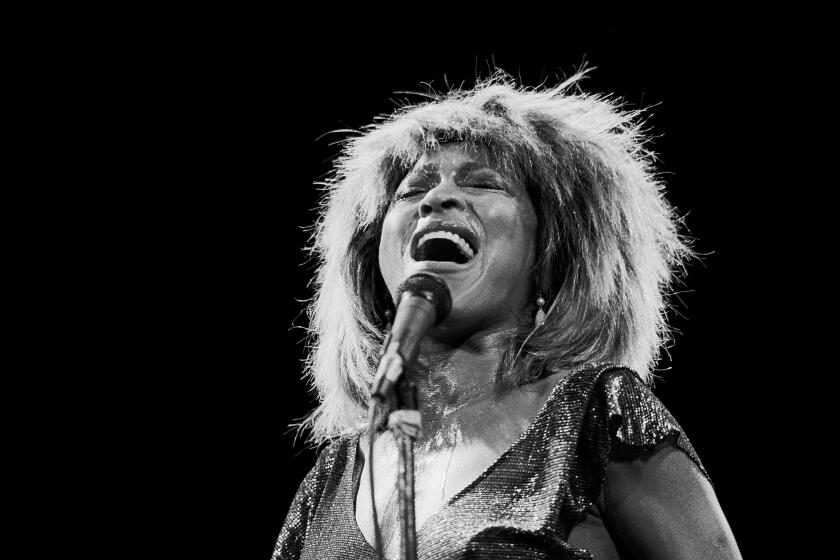10 hidden Tina Turner gems that hold their own against her hits

- Share via
Tina Turner’s legend rested upon a series of enduring hits that happened to tell the arc of her career.
“A Fool in Love,” from 1960, introduced the former Anna Mae Bullock to the world alongside Ike Turner, a journeyman R&B guitarist and talent scout who discovered in the singer a creative and romantic partner. Ike and Tina’s relationship was tumultuous, with Tina suffering considerable physical and psychological abuse at his hands, mistreatment that entered the public record in the 1980s, right after she performed a remarkable comeback with the 1984 album “Private Dancer” and its accompanying hits “What’s Love Got to Do With It” and “Better Be Good to Me.” These songs sit alongside such Ike & Tina singles as “River Deep — Mountain High,” “Proud Mary” and “Nutbush City Limits” as the foundation of Tina’s legacy, the songs that crystallized her image as a fiery, soulful belter who effortlessly conjured a visceral carnality.
Grammy-winning Tina Turner was a rock ’n’ roll original with her high-octane, powerful yet soulful voice and iconic hairstyles.
Although it’s possible to discern the essence of Tina Turner from the signature songs in her canon, dig a little deeper and two things become apparent: During her time with Ike, she pursued every passing trend in rock and R&B; then, once she established herself as a superstar in her own right, she generally played it safe, delivering adult contemporary tunes at a scale that filled arenas. There are gems to be found in the last decade of her career, though, as she demonstrated a quiet control far removed from the chaos and brutality of her previous partnership.
Here, in chronological order, are 10 of Tina Turner’s unheard treasures.
1. “A Fool for a Fool” (1964)

Making the leap from their home of Sue, the label that released “A Fool in Love” in 1960, Ike & Tina Turner signed with Warner Bros. subsidiary Loma Records in 1964. Ike fashioned their first single for the imprint as a gussied-up revision of their old hit, playing off not only the titular phrase but the groove, turning it into something smoother and sweeter. The hints of orchestra and percussion layered through the track hint at the heights they’d soon reach on producer Phil Spector’s “River Deep — Mountain High.”
2. “I Can’t Believe What You Say (For Seeing What You Do)” (1964)

Loyalty was not one of Ike’s attributes. The duo’s contract with Loma brought them some prestige in 1964 but it was only one of three labels to release Ike & Tina Turner records that year. “I Can’t Believe What You Say (For Seeing What You Do)” appeared on the blues imprint Kent in the fall of 1964, but its effervescent pop-soul takes its squeeze from the hits creeping out of Detroit and Chicago. The grain in Tina’s voice and the grit in the rhythm give the record an appealing earthiness.
3. “Two Is a Couple” (1965)

Returning to Sue after having no luck anywhere else, Ike & Tina continued to mine the bright beat of Motown for “Two Is a Couple,” but the single is no replica of The Sound of Young America. The beat hits as hard as Ike’s frayed guitar, a greasy organ is slathered over the rhythms and Tina leans hard into her fury at her man bringing another woman into the relationship. There’s anger at the performance’s core, but the record is an invigorating good time.
4. “Bold Soul Sister” (1969)

“River Deep — Mountain High’’ is one of Ike & Tina’s peak achievements, but it flopped stateside in 1966, leaving the duo to wander through the R&B circuit until their manager Bob Krasnow founded the blues label Blue Thumb in 1968. The next year, they delivered “The Hunter,” an album that splices jammy rock with hard funk. A young Albert Collins traded licks with Ike throughout the record but the highlight was “Bold Soul Sister,” a sprightly blues shuffle. Tina riffs on the title phrase and interjects cathartic wails that tangle with any solo Collins or Ike can muster.
5. “Up in Heah” (1972)

Tina got her sea legs as a songwriter early in the 1970s, working on her own and collaborating with such writers as Leon Ware, a Motown vet who co-wrote much of 1971’s “‘Nuff Said,” the LP that was the sequel to “Proud Mary.” Ware usually worked with Ike, but on this standalone 1972 single he and Tina created a deeply funky song. Tina matches the diamond-hard groove by drawing heavily on her gospel trick bag.
6. “Baby, Get It On (1975)”

The transitional single — the last billed to Ike & Tina Turner and a solo cut on her second album, “Acid Queen” — “Baby, Get It On” capitalizes on Tina’s appearance in Ken Russell’s acid-fried silver-screen adaptation of the Who’s “Tommy” by recasting her as a full-blown glam goddess. On the single version, Ike attempts to keep pace but the longer version makes it clear that only Tina can really keep up with the boot-stomping boogie.
7. “Whole Lotta Love” (1975)

Another single from “Acid Queen,” Tina’s widescreen recasting of Led Zeppelin’s “Whole Lotta Love” as sweaty funk is a rare moment where she opts for a radical revision of a cover. Flipping the script, Ike turns the song into a simmering disco spectacle not far afield from Isaac Hayes’s re-imaginings of Burt Bacharach and Hal David soft-focus pop classics.
8. “Viva La Money” (1978)

Tina transforms Allen Toussaint’s relaxed New Orleans funk number “Viva La Money” into a gleaming glitterball, turning the rhythms toward disco through use of clavinet and wah-wah guitars. Other singers would get crowded by the excessive production — a sound that has its own period charms — but Tina keeps steering it back toward a thick groove.
9. “I Wrote a Letter” (1984)

Unearthed on an expanded 1997 reissue of “Private Dancer,” “I Wrote a Letter” dates from early in the album’s sessions when Capitol’s A&R man John Carter was still searching for the right sound for Tina’s comeback. He found “I Wrote a Letter,” a song written by Inga Rumpf, the leader of the early 1970s Krautrock band Frumpy. As a producer, he steered the anthemic song squarely toward the gap separating heavy AOR rock and stylish new wave — a blend that wasn’t as commercial as “What’s Love Got to Do With It” but showcases Tina’s skills as a defiant rocker.
10. “Unfinished Sympathy” (1996)

After consolidating her “Private Dancer” comeback with 1986’s “Break Every Rule,” Tina increasingly drifted toward glossy adult contemporary, a style where the surrounding calm helped highlight the grain in her voice. She avoided anything that could possibly be classified as “hip” until she recorded Massive Attack’s trip-hop classic “Unfinished Sympathy” for 1996’s “Wildest Dreams.” Compared to the Bristol group’s 1991 original, Turner’s version is subdued and perhaps a bit slick — it lacks a sense of impending drama — yet Tina navigates its turns with grace, even a bit of flair, resulting in one of her best latter-day tracks.
More to Read
The biggest entertainment stories
Get our big stories about Hollywood, film, television, music, arts, culture and more right in your inbox as soon as they publish.
You may occasionally receive promotional content from the Los Angeles Times.











